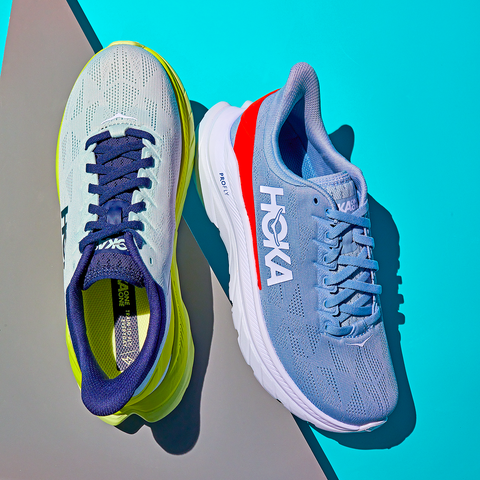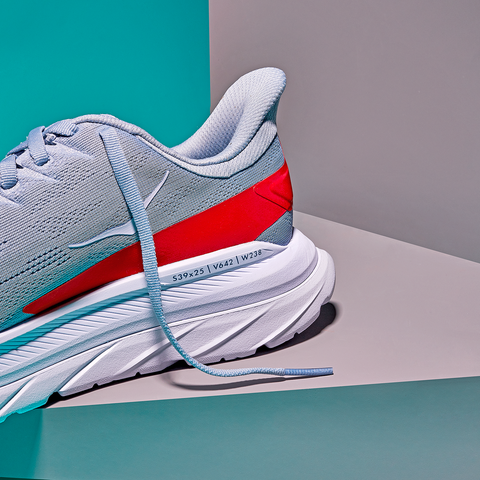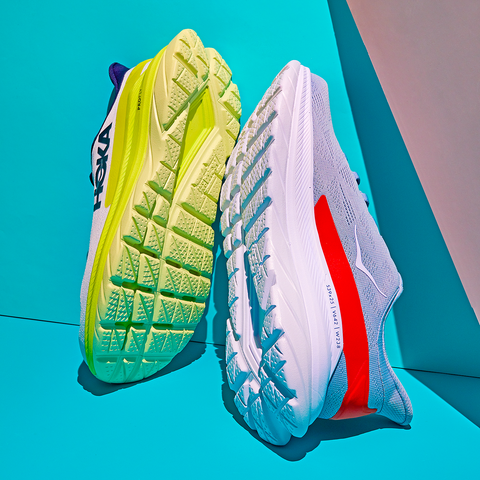The Hoka One One Mach 4 Look Great, and Run Even Better
Welcome to MH Certified, where Men’s Health puts its stamp of approval on the best products you need to look, feel, and live better than ever before.
JUST ABOUT EVERY TIME I get a new pair of shoes to wear test for a review, I take a photo to share them on my Instagram Story.
This happens on a fairly consistent basis. I’ve run in nearly every brand under the sun by now—I have lots of thoughts about all manner of footwear trends, don’t make the mistake of asking me anything about shoes—so when my followers respond particularly well to a certain pair, I take notice. That’s what happened when I posted a fresh shot of Hoka One One’s latest road shoe, the Mach 4. A few people immediately hit me with the 🔥 reaction, and others hopped into my DMs to say they liked the look or to ask how the shoes perform on the road.
At that point, I didn’t have an answer the that question. But now, after a half-dozen training sessions around my typical courses, I can say this: the Mach 4 runs just as good as it looks.

The Mach 4 is positioned as a workhorse shoe that you can wear for every type of run, with a blend of foams for a springy, comfortable ride. The shoes are deceptively light once you put them on, and the mesh upper provides a good lockdown, avoiding the excessively stretchy pitfall of using knit uppers in performance running shoes.
I tested the clean “Blue Fog/Fiesta” colorway, which look more like a crisp grey and crimson IRL, an understated alternative to the overly garish neon runners that thankfully seem to be phasing out of vogue.
The Mach 4 Is All in the Heel

If you’re familiar with Hoka’s other models, you’ll see some familiar design aspects in the Mach 4: the generous foam stack, the subtle rocker shape, and, most tellingly, the extended heel, which is popping up in more of the brand’s kicks lately.
This protrusion isn’t as dramatic as the Clifton Edge (which I love) or, thankfully, the downhill trail-focused TenNine (which I thought was a prank when the massive-soled monstrosities arrived at my desk to test), but the Mach 4’s heel is a statement nonetheless. The construction, which is meant to help ease the impact of the foot striking the ground and smooth out the heel-to-toe transition of each step, isn’t just a novelty or a tech-spec meant for the high-performance models (the Carbon X2 also adds a subtly extended heel to the design); Hoka is making this shape one of its standard features, like the signature maximalist foam stacks that first made the company famous with runners.
When you put the shoes on the road, the Mach 4’s extended heel feels like it’s more than just a design flair. I have a fairly conventional stride, and I feel like the sole’s shape allows me to hit a groove in my run and stick in it without much conscious effort other than picking up my foot for the next step. The sensation isn’t totally dissimilar to the zone I get into when I wear a pair of carbon plate shoes, especially Hoka’s Carbon X2 given their shared design specs. Carbon plate runners are specifically built to propel you forward and maintain your ideal gait with minimal energy expenditure.
The Mach 4’s ride provides a great balance, one that I described to a friend as being cushy and springy, but not too soft that I felt like my foot was sinking into the road or too propulsive that I felt out of control.
The Mach 4 for Everyone

Speaking of the Carbon X2—the Mach 4 looks like a slightly pared down version of Hoka’s most recent race shoes, minus the carbon plates and a bit of foam stack. The company explicitly calls this out in the Mach 4 product description (“built on themes inspired by the Rocket X and Carbon X” is the official line), so it’s not illogical to think of the Mach 4 as the high-level training shoe meant to be paired with the Carbon X2’s race day super shoe. Brooks, Nike, and Saucony all have similar hierarchies within their running shoe lines, so it makes sense that Hoka is following suit with a multiple shoe solution to your next PR.
But for me, the Mach 4 feels more versatile than any of the aforementioned highly tuned training models, or even a carbon plate shoe. The level of comfort just walking around wearing them is part of that, while the eye-catching look is another aspect. I laced the Mach 4 up for a casual outdoor gathering paired with corduroys and a Pendleton sweater and got multiple comments about the kicks, again surprising me at how much people are drawn to them.
I would never wear a carbon plate shoe outside of a high speed training session or race day—in part because they don’t always feel good walking, in part because of their limited lifespans, and in part because they just don’t look good with anything but activewear—so chalk up a lifestyle point to the Mach 4.

This range makes the Mach 4 a great entry for casual runners looking to up their game, especially if they’re not ready to have a shoe solely dedicated to training. Carbon plate shoes are a step up meant for serious athletes and a big investment, cost-wise; I tend to think of them as pro-level tools rather than a fashion accessory. With the Mach 4, you get some of the design cues that have made those shoes a must for serious runners, without the high level specs that make them inaccessible for the layman and unwearable outside of training. They cost a bit less, too, which everyone can appreciate.
Overall, the Mach 4 stand out as a solidly dependable runner that you can wear on the road or with your favorite outfit. You’ll turn heads in both settings, and your feet will feel great when you do it.
Source: Read Full Article


